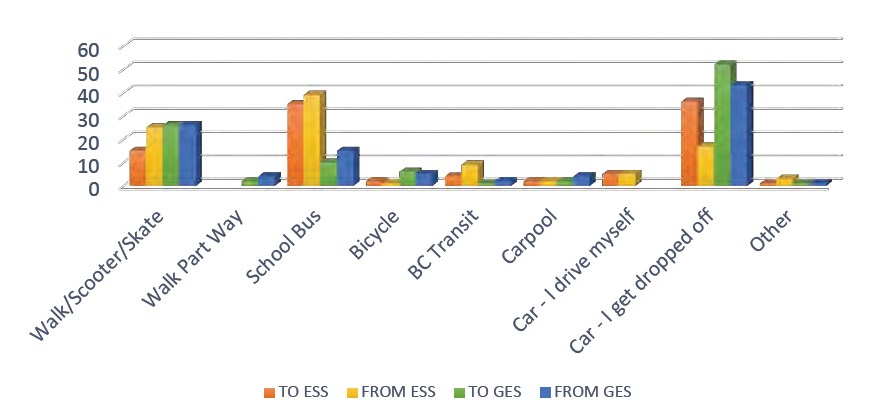The Town of Gibsons is using an $11,500 Active Communities Grant to identify barriers to “active travel,” such as cycling or walking, for people going to and from Gibsons Elementary School and Elphinstone Secondary.
Consultant Johan Stroman told council’s committee of the whole Dec. 18 that “the question that we’re really trying to answer in this project is why are people not walking or biking more in rural communities, and what can we do about it?”
Stroman and an active-travel advisory committee looked at the routes to and from Gibsons Elementary, located at the intersection of School Road, North Road and Gibsons Way, and Elphinstone Secondary, which is on Gibsons Way just west of the elementary school.
They wanted to know how students were getting to and from school and what concerns they had about safety along the way.
About 56 per cent of Gibsons Elementary students live within 1.6 kilometres of the school.
A survey of students and their families found that close to half of the students were regularly driven to and from school. Thirty per cent typically walk, 17 per cent take a school bus and three to six per cent cycle, while one to three per cent are part of a car pool.
The majority of students, 75 per cent, travel with a parent or grandparent, and 81 per cent of the respondents agreed or strongly agreed that it is safe for children to walk to school.
A similar survey conducted at Elphinstone led to results that speak to the differences between high school and elementary school, and the wider catchment area.
Seventy-one per cent of the student body live more than 1.6 kilometres away from school, and 40 per cent of those are over three kilometres away.
The high school students were more likely to use Sunshine Coast Transit or school buses than their elementary counterparts, and less likely to cycle or walk, and a small percentage use their own vehicles to get to and from school.
Stroman said when they asked about people’s concerns, they broke them down into two broad categories: engineering and behaviour.
“The biggest concerns we saw for engineering were people asking for upgrades in crosswalks, pedestrian controlled lights, bike lanes, wider shoulders and sidewalks,” Stroman said. In the behaviour category, the top concern was driving – things like distracted driving and drivers making rolling stops. Traffic volumes were the second biggest concern.
Twenty “hot spots” were identified on the commonly used routes, including the main intersection near Gibsons Elementary, which had between 800 and 950 vehicles go through in the course of just over an hour when the group did a morning traffic count.
Mayor Bill Beamish said because his wife works at the school, he sees a lot of issues caused by a parking lot that “is not very well designed.”
“I would like to suggest we consider a right hand turn only out of that parking lot during the morning and during the afternoon when the kids are being picked up, because that left hand turn creates more congestion up at the corner,” Beamish said.
Stroman also drew the committee’s attention to one area outside the Town boundaries – Highway 101 between Oceanview Drive and Payne Road.
There were 33 “concern responses” related to that stretch of the highway. Twenty-two fell into the engineering category, such as lack of crosswalks, narrow shoulders, and no sidewalk, and 11 were behaviour related, such as speeding, driver inattention and heavy traffic.
That area has also been highlighted by community members pushing for better highway safety, and was the subject of a petition this summer sponsored by the Woodcreek Park Neighbourhood Association and the Elphinstone Community Association calling for, among other measures, a reduction in the speed limit.
The Town isn’t taking any specific action on Stroman’s report at this point, and the committee recommended it be forwarded to School District No. 46, Vancouver Coastal Health, the Ministry of Transportation, RCMP and Transportation Choices Sunshine Coast for information.
Stroman said when it comes to taking action based on the study’s findings, the Town should focus first on the neighbourhoods closest to the two schools.
“If we make it safe for an eight-year-old to get there, and an 80-year-old, then all the rest of us will fit in somewhere in there.”



